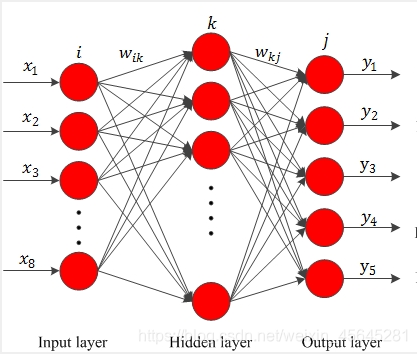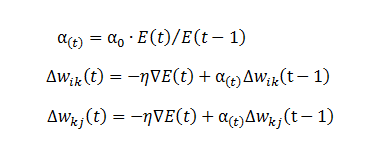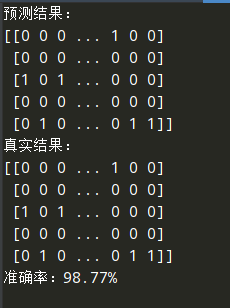机器学习-自适应学习率和损失函数的反向传播神经网络BPNN
问题背景:多分类问题,输入参数为8组特征值,采用Excel表格导入,输出参数为5种不同的分类结果。数据量为1000组左右,训练组与测试组保持为7:3。
BP神经网络模型:隐藏层计算为10层,达到最大准确率,且时间较短。

学习率更新公式:

损失函数更新公式:

有几个超参数需要提前设置好,根据自己的问题背景环境。
import numpy as np
import datetime
import xlrd
import matplotlib.pyplot as plt
from sklearn.metrics import roc_curve
def noramlization(data):
minVals = data.min(0)
maxVals = data.max(0)
ranges = maxVals - minVals
normData = (data - minVals)/ranges
return normData
# 0.读入数据
def load_excel(path):
result_array=[]
# 读取初始数据
data = xlrd.open_workbook(path)
table = data.sheet_by_index(0)
# table.nrows表示总行数
for i in range(table.nrows):
# 读取每行数据,保存在line里面,line是list
line = table.row_values(i)
# 将line加入到result_array中,result_array是二维list
result_array.append(line)
# 将result_array从二维list变成数组
result_array = np.array(result_array)
return result_array
# 1.初始化参数
def initialize_parameters(n_x, n_h, n_y):
np.random.seed(2)
# 权重和偏置矩阵
w1 = np.random.rand(n_h, n_x) * 0.1
#b1 = np.random.rand(n_h, 1)
b1 = np.zeros(shape=(n_h, 1))
w2 = np.random.rand(n_y, n_h) * 0.1
#b2 = np.random.rand(n_y, 1)
b2 = np.zeros(shape=(n_y, 1))
# 通过字典存储参数
parameters = {'w1': w1, 'b1': b1, 'w2': w2, 'b2': b2}
return parameters
# 更新权重和阈值
def update_temp(parameters):
w1 = parameters['w1']
b1 = parameters['b1']
w2 = parameters['w2']
b2 = parameters['b2']
temp = {'w1': w1, 'b1': b1, 'w2': w2, 'b2': b2}
return temp
def update_wb(parameters,temp):
w1 = parameters['w1']
b1 = parameters['b1']
w2 = parameters['w2']
b2 = parameters['b2']
temp_w1 = temp['w1']
temp_b1 = temp['b1']
temp_w2 = temp['w2']
temp_b2 = temp['b2']
m1 = w1- temp_w1
n1 = b1- temp_b1
m2 = w2 - temp_w2
n2 = b2 - temp_b2
update_para = {'m1': m1, 'n1': n1, 'm2': m2, 'n2': n2}
return update_para
# 2.前向传播
def forward_propagation(X, parameters):
w1 = parameters['w1']
b1 = parameters['b1']
w2 = parameters['w2']
b2 = parameters['b2']
# 通过前向传播来计算a2
z1 = np.dot(w1, X) + b1 # 这个地方需注意矩阵加法:虽然(w1*X)和b1的维度不同,但可以相加
a1 = np.tanh(z1) # 使用tanh作为第一层的激活函数
z2 = np.dot(w2, a1) + b2
# exp = np.exp(z2)
# sum_exp = np.sum(np.exp(z2), axis=0, keepdims=True)
# a2 = exp / sum_exp
a2 = 1 / (1 + np.exp(-z2)) # 使用sigmoid作为第二层的激活函数
# 通过字典存储参数
cache = {'z1': z1, 'a1': a1, 'z2': z2, 'a2': a2}
return a2, cache
# 3.计算代价函数
def compute_cost(a2, Y, parameters):
m = Y.shape[1] # Y的列数即为总的样本数
# 采用交叉熵(cross-entropy)作为代价函数
logprobs = np.multiply(np.log(a2), Y) + np.multiply((1 - Y), np.log(1 - a2))
#logprobs = np.multiply(np.log(a2), Y)
cost = - np.sum(logprobs) / m
return cost
# 4.反向传播(计算代价函数的导数)
def backward_propagation(parameters, cache, X, Y):
m = Y.shape[1]
w2 = parameters['w2']
a1 = cache['a1']
a2 = cache['a2']
# 反向传播,计算dw1、db1、dw2、db2
dz2 = a2 - Y
dw2 = (1 / m) * np.dot(dz2, a1.T)
#print(dw2.shape)
db2 = (1 / m) * np.sum(dz2, axis=1, keepdims=True)
dz1 = np.multiply(np.dot(w2.T, dz2), 1 - np.power(a1, 2))
dw1 = (1 / m) * np.dot(dz1, X.T)
db1 = (1 / m) * np.sum(dz1, axis=1, keepdims=True)
grads = {'dw1': dw1, 'db1': db1, 'dw2': dw2, 'db2': db2}
return grads
def update_learn(learning_rate,i,num_iterations):
learning=learning_rate*(1-i/num_iterations)
return learning
# 5.更新参数
def update_parameters(parameters, grads,update_para,learning_rate,k):
w1 = parameters['w1']
b1 = parameters['b1']
w2 = parameters['w2']
b2 = parameters['b2']
dw1 = grads['dw1']
db1 = grads['db1']
dw2 = grads['dw2']
db2 = grads['db2']
m1 = update_para['m1']
n1 = update_para['n1']
m2 = update_para['m2']
n2 = update_para['n2']
# 更新参数
w1 = w1 - dw1 * learning_rate + m1 * k*0.9
b1 = b1 - db1 * learning_rate + n1 * k*0.9
w2 = w2 - dw2 * learning_rate + m2 * k*0.9
b2 = b2 - db2 * learning_rate + n2 * k*0.9
parameters = {'w1': w1, 'b1': b1, 'w2': w2, 'b2': b2}
return parameters
# 建立神经网络
def nn_model(X, Y, n_h, n_input, n_output, num_iterations=10000, print_cost=False):
np.random.seed(3)
n_x = n_input # 输入层节点数
n_y = n_output # 输出层节点数
# 1.初始化参数
learning_rate=0.1
parameters = initialize_parameters(n_x, n_h, n_y)
temp = update_temp(parameters)
cost_list=[]
grads_list=[]
j = 1
# 梯度下降循环
for i in range(0, num_iterations):
learning=update_learn(learning_rate,i,num_iterations)
# 2.前向传播
a2, cache = forward_propagation(X, parameters)
# 3.计算代价函数
cost = compute_cost(a2, Y, parameters)
cost_list.append(cost)
# 4.反向传播
grads = backward_propagation(parameters, cache, X, Y)
# 5.更新参数
update_para = update_wb(parameters, temp)
k=1
if j==i:
temp=update_temp(parameters)
j=j+1
k=cost/ttt
ttt = cost
parameters = update_parameters(parameters, grads, update_para,learning_rate=learning,k=k)
grads_list.append(k)
# 每1000次迭代,输出一次代价函数
if print_cost and i % 1000 == 0:
print('迭代第%i次,代价函数为:%f' % (i, cost))
plt.plot(cost_list)
#plt.plot(grads_list)
return parameters,cost_list
# 对模型进行测试
def predict(parameters, x_test, y_test):
w1 = parameters['w1']
b1 = parameters['b1']
w2 = parameters['w2']
b2 = parameters['b2']
z1 = np.dot(w1, x_test) + b1
a1 = np.tanh(z1)
z2 = np.dot(w2, a1) + b2
# exp = np.exp(z2)
# sum_exp = np.sum(np.exp(z2), axis=0, keepdims=True)
# a2 = exp / sum_exp
a2 = 1 / (1 + np.exp(-z2))
# 结果的维度
n_rows = y_test.shape[0]
n_cols = y_test.shape[1]
# 预测值结果存储
output = np.empty(shape=(n_rows, n_cols), dtype=int)
# 取出每条测试数据的预测结果
for i in range(n_cols):
# 将每条测试数据的预测结果(概率)存为一个行向量
temp = np.zeros(shape=n_rows)
for j in range(n_rows):
temp[j] = a2[j][i]
# 将每条结果(概率)从小到大排序,并获得相应下标
sorted_dist = np.argsort(temp)
length = len(sorted_dist)
# 将概率最大的置为1,其它置为0
for k in range(length):
if k == sorted_dist[length - 1]:
output[k][i] = 1
else:
output[k][i] = 0
print('预测结果:')
print(output)
print('真实结果:')
print(y_test)
count = 0
for k in range(0, n_cols):
if output[0][k] == y_test[0][k] and output[1][k] == y_test[1][k] and output[2][k] == y_test[2][k]\
and output[3][k] == y_test[3][k] and output[4][k] == y_test[4][k]:
count = count + 1
acc = count / int(y_test.shape[1]) * 100
print('准确率:%.2f%%' % acc)
return output,acc
def cross_validation():
pass
if __name__ == "__main__":
# 读取数据
data_normal = load_excel('E:/exp/1.xlsx')
data_sunken = load_excel('E:/exp/2.xlsx')
data_undercut = load_excel('E:/exp/3.xlsx')
data_pore = load_excel('E:/exp/4.xlsx')
data_burnthrough = load_excel('E:/exp/5.xlsx')
#test_weld = load_excel('E:/exp/test.xlsx')
# 生成数据集
y11 = np.array([1,0,0,0,0])
y1 = np.tile(y11,(data_normal.shape[0],1))
#y11 = np.zeros((data_normal.shape[0], 1))
c1 = np.concatenate((data_normal, y1), axis=1)
y22 = np.array([0,1,0,0,0])
y2 = np.tile(y22,(data_sunken.shape[0],1))
#y2 = np.ones((data_sunken.shape[0], 1)) * 1
c2 = np.concatenate((data_sunken, y2), axis=1)
y33 = np.array([0,0,1,0,0])
y3 = np.tile(y33,(data_undercut.shape[0],1))
#y3 = np.ones((data_undercut.shape[0], 1)) * 2
c3 = np.concatenate((data_undercut, y3), axis=1)
y44 = np.array([0,0,0,1,0])
y4 = np.tile(y44,(data_pore.shape[0],1))
#y4 = np.ones((data_pore.shape[0], 1)) * 3
c4 = np.concatenate((data_pore, y4), axis=1)
y55 = np.array([0,0,0,0,1])
y5 = np.tile(y55,(data_burnthrough.shape[0],1))
#y5 = np.ones((data_burnthrough.shape[0], 1)) * 4
c5 = np.concatenate((data_burnthrough, y5), axis=1)
#######load samples##
# np.random.shuffle(c1)
# np.random.shuffle(c2)
# np.random.shuffle(c3)
# np.random.shuffle(c4)
# np.random.shuffle(c5)
# yuan = np.concatenate((c1[:75,:], c2[:75,:], c3[:75,:], c4[:75,:], c5[:75,:]), axis=0)
#########
#all_data=load_excel('E:/temp.xlsx')
all_data = np.concatenate((c1, c2, c3, c4, c5), axis=0)
np.random.shuffle(all_data)
# train_data_x1 = all_data[:1089, :8].T
# train_data_y1 = all_data[:1089, 8:13].T
# train_data_x2 = all_data[1218:, :8].T
# train_data_y2 = all_data[1218:, 8:13].T
# train_data_x=np.concatenate((train_data_x1,train_data_x2),axis=1)
# train_data_y = np.concatenate((train_data_y1, train_data_y2), axis=1)
train_data_x = all_data[:812, :8].T
train_data_y = all_data[:812, 8:13].T # 训练集
# #test_data_x=test_weld[:,:8].T
# #test_data_y=test_weld[:,8:13].T
test_data_x = all_data[812:, :8].T
test_data_y = all_data[812:, 8:13].T # 测试集
# test_data_x = all_data[1089:1218, :8].T
# test_data_y = all_data[1089:1218, 8:13].T
train_data_y = train_data_y.astype('uint8')
train_data_x=noramlization(train_data_x)
test_data_x=noramlization(test_data_x)
# 开始训练
start_time = datetime.datetime.now()
# 输入8个节点,隐层10个节点,输出5个节点,迭代10000次
parameters,result= nn_model(train_data_x, train_data_y, n_h=13, n_input=8, n_output=5, num_iterations=10000, print_cost=True)
end_time = datetime.datetime.now()
print("用时:" + str((end_time - start_time).seconds) + 's' + str(round((end_time - start_time).microseconds / 1000)) + 'ms')
# 对模型进行测试
test_data_y = test_data_y.astype('uint8')
#o,t=predict(parameters, train_data_x, train_data_y)
p,acc=predict(parameters, test_data_x,test_data_y)
#np.savetxt('E:/exp/weld detect/result_test.txt',yuan)
#np.savetxt('E:/exp/weld detect/result_predict.txt', p.T)
损失函数:

准确率:




